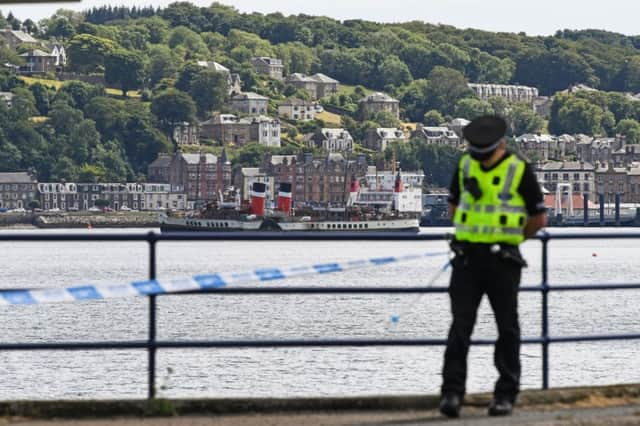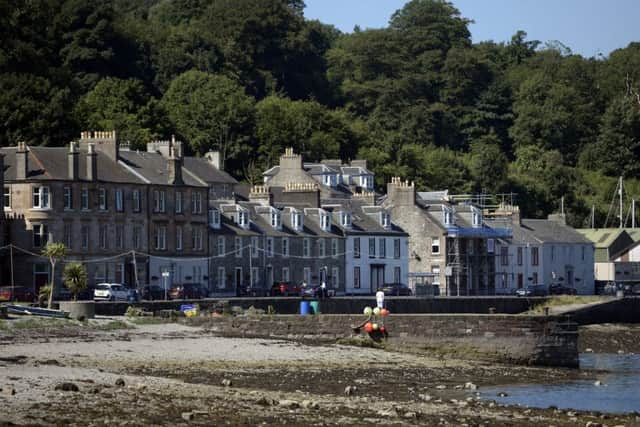Bute islanders host holiday season with heavy hearts after Alesha MacPhail tragedy


Several are pulling suitcases, a sign they plan an extended stay rather than a day trip. It’s a short stroll through the Victorian terminus to the waiting ferry bound for Rothesay. The station’s grand architecture and its sheer size are reminders of just how popular the Isle of Bute once was as a holiday destination. Even today, it’s easy to get caught up in the holiday spirit.
“As a child, these used to feel warm!” exclaims one middle-aged passenger as he poses for a picture next to one of the ferry’s twin funnels. Bute is the kind of place that draws you back, even if it’s been several decades since your last visit. Rothesay, with its grand pavilion and putting greens, is a town where happy memories are made. But the island, which has a population of under 7,000, has endured one of its toughest weeks in living memory.
Advertisement
Hide AdAdvertisement
Hide AdLast week, the body of Alesha MacPhail, six, was found in woodland near Port Bannatyne, two miles from Rothesay. The girl had been staying at her grandmother’s house in Ardbeg Road when she was reported missing at 6.25am on Monday. Two days later, police charged a 16-year-old boy, who cannot be named for legal reasons, in connection with her death.


“Tragedy visits Bute” was the banner headline in one local newspaper. Residents are not accustomed to dealing with such crimes, or any crime for that matter. Councillor Len Scoullar, who has lived on the island since 1969, said many still left their front doors unlocked and even kept car keys in the ignition.
The beginning of the school holidays marks the start of the traditional summer season in Rothesay.
While visitor numbers are far from what they used to be in the days before package holidays, tourism remains the backbone of the local economy.
The town and surrounding area boast an impressive list of attractions. The remains of an imposing medieval castle are a short walk from the pier, past streets full of independent businesses and numerous pubs. You can also take your pick from several beaches in the vicinity.
“It has the feeling of a great Victorian resort,” says Kirsteen Kane, who has travelled down from Lochwinnoch in Renfrewshire with her two young sons and two of their friends. “This is the first time I’ve been in five years.” Kane knows the island well, having formerly worked at Mount Stuart, the palatial 19th century home built for the third Marquess of Bute and now a popular wedding venue for the rich and famous.
The tragic events of the past week did not put her off from visiting. “People should be supporting local resorts like Bute,” she added. “It would be terrible if businesses started to suffer as a result.”
Looking across Rothesay Bay is Victoria Street, which is lined by the kind of small shops, selling everything from paint to picture frames, that were once common in mainland town centres before chain stores took control. Among them is Mave’s Lucky Box, owned by Andrew Murie. Originally from Auckland, New Zealand, he has lived in Bute for 18 months. He settled on Rothesay after spending several years exploring the west coast. “The location is the main attraction,” he explains while leaning on his counter at lunchtime. “I mean, the scenery is incredible – and I’ve probably seen more of Scotland than most Scots.
Advertisement
Hide AdAdvertisement
Hide Ad“How come I ended up in Bute? The community spirit is right up there. Everybody knows everybody, and stops to say hello. I think a lot of society has lost that. It’s a step back in pace here.”
The events of last week have taken a heavy toll on everyone in the town. “Just devastating” is how Murie sums up the mood. He believes the island will come together as a result. “We endured a very hard winter,” he says. “But the summer weather has been the best I can remember. More people will come to visit.”
Much of the employment on Bute, like many island communities, is seasonal. Work can be hard to come by in winter, particularly for the young. But a few big companies have been tempted to open bases on Bute in recent years.
A manager at one such firm, who asked not to be named, has seen how recent events have impacted on his workforce. “Last week, the mood in the office was so happy – the sun was shining and tourists were arriving on the island for a summer holiday,” they said. “But this week, even though the sun is still shining, the mood is very sombre.
“No one expects something like that to happen in such a small place. As you can imagine, it’s all people are talking about. A couple of people have told me they’ve been violently sick thinking about the news.”
Yet Bute retains a magic that is hard to shake. David McLaughlan, originally from Aberdeen, has travelled north from London to attend a family wedding on the island. It’s his first time in Rothesay. While disembarking from the ferry, he eagerly takes pictures of the town and its dramatic landscape. “I heard the news and thought it must have rocked the community hard,” he says. “But you just need to look at the place to know you’ll enjoy spending time here.”